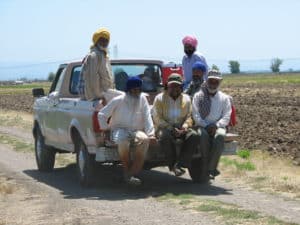
A couple of weeks ago, Randall “Cass” Mutters took Rob, Mike, and me on a tour of the rice industry in Northern California. Cass is the rice farm advisor at UC Cooperative Extension, Butte County with an office just down the hallway of my own. According to www.calrice.org, 95% of the state’s rice is grown north of Sacramento – my region. About 2 million tons of rice is produced annually. Driving around the area always made me wonder about rice production, especially because of the oddity of seeing fields of standing water. Northern California is notorious for the lack of rain in the summer, so it was a curiosity of why rice growers ended up in this region. However, Cass said rice takes about the same amount of water as a walnut orchard of the same size or a grass lawn. The region is ideal for growing rice since the soil is heavy clay and does not readily absorb water.
We followed the path of the water going into the rice patties starting with Lake Oroville

(the 2nd largest reservoir in CA, fed largely by mountain snow melt) made by Oroville Dam (the tallest dam and one of the largest earthen dams in the States), down to the Feather River, forebay, afterbay, canals, and then the rice patties. We saw a rice cooperative in Richvale, where the harvested rice is taken to be dried, hulled, and packaged. We saw conventional and organic rice paddies. The most interesting place was the Rice Field Station in Richvale, where they breed different varieties of rice by doing crosses and then testing the crosses. They had plantings of 25,000-30,000 different varieties. It is astounding to think that there can be that many factors in rice to come up with 25,000 different varieties. Each of the new varieties were hand-planted in small and had to be hand-weeded. The workers have to wade in the water all day to weed.

Some go barefoot.
While the patties are full of water, they act as a habitat to wetland animals. We saw crayfish, beetles, birds, frogs, and smelled a skunk.
For a girl from the Midwest where corn, wheat, and soybeans rule, it was great to finally satisfy some of my curiosity about this unusual crop.